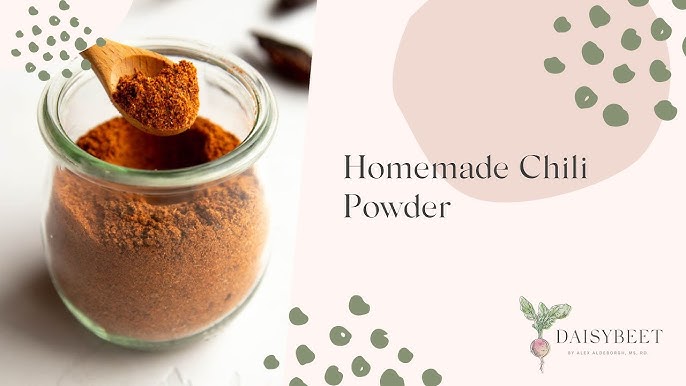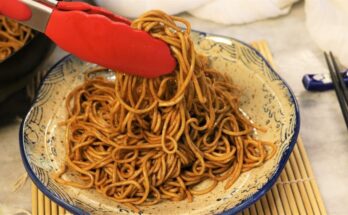Chili Powder Recipe: If you’ve ever cooked with chili powder, you know it’s that magical touch that turns an average dish into something bold and unforgettable. But have you ever tried making it from scratch? Believe it or not, crafting your own chili powder at home isn’t just a cool kitchen experiment—it’s a total game changer for flavor and freshness.
Most store-bought chili powders are loaded with additives, fillers, and preservatives. They lose their zing over time sitting on supermarket shelves. On the flip side, homemade chili powder is vibrant, fragrant, and completely tailored to your taste. Want something spicier? Milder? Smokier? You’re the boss.
In this guide, we’ll break it down for you step by step. Whether you’re a spice enthusiast or someone who’s just diving into the world of DIY seasonings, you’ll find this process easy, rewarding, and downright tasty. So, let’s fire things up and start grinding!
Ingredients Needed for Chili Powder
When it comes to making chili powder, the ingredient list is actually pretty simple. It starts with dried chilies—your main flavor and heat source. Then, you layer in a few more spices to give it that familiar depth and warmth. Here’s a basic breakdown:
Common Spices Used
- Dried chilies (whole) – Choose based on your heat tolerance (more on that later).
- Cumin seeds – Adds earthy, slightly smoky flavor.
- Garlic powder – For that punchy, savory kick.
- Onion powder – Balances the flavors and deepens the aroma.
- Oregano (preferably Mexican) – Adds herbal freshness.
- Paprika (smoked or sweet) – Enhances color and complexity.
These ingredients form the backbone of your chili powder. They all contribute to that robust, well-rounded flavor profile that makes chili powder so versatile in the kitchen.
Optional Add-ins for Flavor Customization
- Cinnamon – Just a pinch for a sweet, warm note.
- Clove or allspice – For a spiced-up twist.
- Coriander seeds – Brings a citrusy zing.
- Chipotle powder – Adds extra smokiness and heat.
The beauty of DIY chili powder is that you can tailor it to fit your palate. Like it super hot? Throw in some arbol or ghost peppers. Prefer it milder with a rich aroma? Stick with ancho or guajillo chilies. This is your spice journey!
Choosing the Right Chilies
Not all chilies are created equal. In fact, your entire chili powder flavor depends heavily on the type and quality of chilies you choose. Here’s how to pick the best ones for your custom blend.
Types of Chilies and Their Heat Levels
- Ancho Chilies – Mild, slightly sweet, and fruity. Great for a rich, dark chili powder.
- Guajillo Chilies – Medium heat with a tangy, berry-like flavor.
- Pasilla Chilies – Earthy and mild with a raisin-like undertone.
- Arbol Chilies – Fiery hot and ideal for serious spice lovers.
- Chipotle Chilies – Smoky, spicy, and bold. Often used for a BBQ-style chili powder.
- Cascabel or Mulato – Less common, but add depth and complexity.
Pro tip: Mix and match! Combining 2-3 different chili varieties can give you a more balanced and interesting flavor.
How to Select the Best Quality Chilies
Always choose whole dried chilies that are pliable and not brittle. The skin should be glossy and free from mold or dark spots. Avoid chilies that are too hard or have lost their color—these are signs of age and lack of potency.
It’s best to buy from a reputable spice shop or ethnic grocery store where turnover is high. That way, you’re more likely to get fresher ingredients that haven’t been sitting around for ages.
Tools and Equipment Required
Before diving into chili powder making, let’s get your tools in order. The right gear makes a world of difference in texture, aroma, and ease of preparation.
Essential Tools
- Heavy skillet or pan – For toasting your chilies and spices.
- Kitchen scissors or a sharp knife – To cut chilies and remove stems/seeds.
- Coffee or spice grinder – For that fine, even powder consistency.
- Fine mesh strainer (optional) – Helps sift out any coarse bits after grinding.
Storage Containers
- Airtight glass jar or spice container – Keeps moisture out and flavor in.
- Labels – Especially handy if you make multiple blends or variations.
Don’t have a grinder? No worries! A high-speed blender or even a mortar and pestle can do the job. Just be ready for a bit more effort. Either way, cleanliness is key—make sure everything is dry and sanitized before you begin.
Step-by-Step Guide to Making Chili Powder
Now that we’ve got our ingredients and tools prepped, it’s time to dive into the fun part: making your chili powder. Here’s the step-by-step breakdown to get that perfect, aromatic blend right in your own kitchen.
Step 1: Prepare the Chilies
- Cut the stems off each chili.
- Shake or scrape out the seeds. (You can keep a few if you like extra heat.)
- Tear the chilies into small pieces to help them toast evenly.
Removing the seeds and stems helps reduce bitterness and ensures your powder is smooth and flavorful.
Step 2: Toast the Chilies
This step is where the magic starts. Toasting the chilies brings out their natural oils, intensifies their flavor, and gives your chili powder that rich, smoky depth.
- Heat a heavy skillet or pan (cast iron works great) over medium heat.
- Add the chili pieces in a single layer, pressing them slightly against the pan.
- Toast for 10-15 seconds per side, just until they puff slightly and become fragrant. Be careful not to burn them—burned chilies turn bitter fast!
- Remove immediately and let them cool.
Pro tip: Keep a window open or fan on—this step can release some pretty potent aromas that may make you sneeze!
Step 3: Add Additional Spices
Once your chilies are toasted and cooled, it’s time to prepare your additional flavorings.
- Measure out your other spices—cumin seeds, garlic powder, onion powder, oregano, paprika, and any extras you’re using like cinnamon or coriander.
- If you’re using whole spices (like cumin seeds or coriander seeds), toast them lightly in the same skillet until fragrant (about 30-60 seconds).
This step helps amplify their natural flavor and aroma, and brings them on par with the toasted chilies.
Step 4: Grinding the Mixture
Here’s where everything comes together into that beautiful, fine chili powder.
- Add the cooled chili pieces to your spice or coffee grinder first. Pulse until you have a coarse powder.
- Next, add your toasted and ground spices to the mix.
- Grind everything together until the texture is as fine or coarse as you like. (Most people prefer a fine powder.)
If you notice any large flakes or seeds remaining, sift the powder through a fine mesh sieve and grind the leftovers again.
Pro tip: Give your grinder a quick wipe before and after using to avoid mixing flavors, especially if you use it for coffee too!
Step 5: Storing the Chili Powder
Congrats—you’ve just made homemade chili powder! Now it’s time to store it properly so all that hard work doesn’t go to waste.
- Transfer the finished powder into a clean, airtight glass jar or container.
- Label it with the date and type of chilies you used.
- Store it in a cool, dry, and dark place—like a spice cabinet or pantry.
When stored properly, homemade chili powder can retain its flavor for up to 6 months—sometimes even longer. But trust me, once you start using it, it’ll be gone long before then!
Tips for Customizing Your Chili Powder
One of the coolest things about homemade chili powder is how flexible it is. Don’t like heat? No problem. Want it smoky? Easy fix. Let’s talk customizations:
Mild, Medium, and Hot Variants
- For mild blends, stick with ancho, pasilla, and mulato chilies.
- For medium heat, try combining guajillo, chipotle, and a touch of arbol.
- For high heat, go all in with cayenne, Thai dried chilies, or even ghost peppers.
Adding Smokiness or Sweetness
- Smoked paprika or chipotle gives that BBQ-style flavor.
- Cinnamon or clove can add a sweet, warm undertone.
- Add a small amount of brown sugar (about 1/2 tsp) if you’re going for a rub-style chili powder for meats.
You can also play with ratios—more cumin for earthiness, more oregano for an herbal pop. The possibilities are endless!
Common Mistakes to Avoid
Even though making chili powder is straightforward, there are a few pitfalls to steer clear of:
Over-toasting the Chilies
This is a biggie. It’s super easy to go from perfectly toasted to scorched. Once burnt, the chilies turn bitter and can ruin your whole batch. Stick to 10–15 seconds per side and trust your nose.
Using Moist or Old Ingredients
Moisture is the enemy here. Make sure everything is fully dry before grinding, or you could end up with clumpy powder or worse—mold. Also, skip chilies that look faded or brittle. They’ve likely lost most of their flavor.
Not Grinding Thoroughly
A chunky chili powder isn’t the end of the world, but it may not mix well in your dishes. Use a fine mesh sieve to catch large bits and grind them again.
Not Labeling Your Batch
Especially if you make multiple kinds or plan to gift them, labeling your jars is essential. Nothing worse than forgetting which blend was your mild one and which will set your mouth on fire!
How to Store and Preserve Your Chili Powder
Storing your homemade chili powder the right way is just as important as making it. You’ve put in the time and effort to toast, blend, and grind your spices—don’t let poor storage ruin the freshness and potency of your creation.
Best Practices for Storage
- Use airtight containers: Glass jars with tight lids are ideal. Mason jars or recycled spice bottles work perfectly. Avoid plastic containers—they can absorb aromas and may affect flavor over time.
- Keep it in a cool, dry place: Store your jar in a pantry or cupboard away from heat and direct sunlight. Heat and moisture are the fastest ways to degrade spice flavor.
- Don’t store near the stove: It might be convenient, but the heat and humidity from cooking can cause your spices to lose potency quickly.
Shelf Life
Homemade chili powder can last up to 6 months if stored properly. After that, it won’t go “bad,” but the flavor and aroma will begin to fade. You’ll still be able to use it, but it might not have the same punch.
How to Tell If It’s Gone Stale
- Dull aroma: If you open the jar and don’t get hit with a wave of spice, it’s probably past its prime.
- Faded color: Bright red turning brown? That’s a sign the spices are oxidizing and losing strength.
- Clumping: This can mean moisture has gotten in. If you spot mold, toss it immediately.
To extend shelf life, consider vacuum sealing or keeping a desiccant packet (like silica gel) inside the jar to absorb moisture.
Culinary Uses of Chili Powder
Now that you’ve made your own chili powder, you’re probably wondering—what can I do with it? Well, a lot! Homemade chili powder is one of the most versatile ingredients in your spice rack.
Everyday Cooking Ideas
- Chili and stews: This one’s a no-brainer. Add a tablespoon or two to your favorite chili recipe to bring that deep, complex heat.
- Taco seasoning: Mix your chili powder with cumin, garlic powder, onion powder, and oregano for a DIY taco blend.
- Soups and sauces: Stir into tomato-based soups or enchilada sauces for a spicy kick.
- Marinades and rubs: Combine with olive oil, salt, and lemon for a flavorful meat marinade or dry rub.
- Eggs and breakfast dishes: Sprinkle a pinch over scrambled eggs, omelets, or even avocado toast for a bold start to your day.
Creative Pairings
- Hot chocolate or mole: A touch of chili powder in chocolate dishes can be divine. It adds warmth and complexity.
- Roasted veggies: Toss veggies like sweet potatoes, carrots, or cauliflower in oil and chili powder before roasting.
- Popcorn topping: Mix chili powder with a little salt and nutritional yeast or Parmesan for a spicy snack.
This chili powder will become your secret weapon in the kitchen. It’s that one ingredient you’ll reach for to add depth, warmth, and a subtle heat to just about any dish.
Health Benefits of Homemade Chili Powder
Beyond just flavor, chili powder offers a surprising number of health benefits, especially when made fresh without preservatives or additives.
Packed with Nutrients
- Vitamin A: Derived from the chilies themselves, it’s essential for eye health and immune function.
- Capsaicin: This is the compound that gives chilies their heat, and it’s known to have anti-inflammatory and pain-relieving properties.
- Antioxidants: Garlic, paprika, and oregano all bring antioxidant power to the mix, helping to combat free radicals in the body.
Boosts Metabolism
Capsaicin can temporarily increase your metabolic rate, helping your body burn more calories. It’s not a miracle cure, but it’s a nice little bonus if you’re into healthy eating.
Good for Digestion
Spices like cumin and garlic have been traditionally used to aid digestion. They can stimulate the appetite and promote the production of digestive enzymes.
No Additives, No Junk
Unlike store-bought blends that may include anti-caking agents or artificial flavoring, your homemade version is 100% clean. You know exactly what’s in it—and what’s not.
Just remember, moderation is key. Chili powder is potent stuff, and while it’s healthy, overuse can lead to stomach upset for some people.
FAQs about Chili Powder Recipe
1. What ingredients are in homemade chili powder?
Homemade chili powder typically includes dried chili peppers, garlic powder, onion powder, cumin, paprika, and oregano. You can customize it to suit your heat preference.
2. How do I store chili powder?
Store it in an airtight container in a cool, dark place like a pantry. It can stay fresh for up to 6 months, though its flavor is best within 3 months.
3. Can I use fresh chilies instead of dried ones?
For chili powder, dried chilies are preferred because they grind into a powder and offer a more concentrated flavor. Fresh chilies are better for sauces or pastes.
4. Is chili powder the same as cayenne pepper?
No, chili powder is a blend of spices and is milder. Cayenne pepper is made from ground cayenne chilies and is much spicier.
5. Can I adjust the spice level in homemade chili powder?
Absolutely! Use mild chilies like ancho for a mellow heat or add spicier ones like arbol or cayenne for more kick.
Conclusion
There’s something incredibly satisfying about creating your own spice blends—especially one as versatile and flavorful as chili powder. With just a handful of ingredients, a little toasting, and some grinding, you’ve made something far superior to what’s on grocery store shelves.
Homemade chili powder gives you total control. You pick the heat level. You choose the flavor profile. And best of all, you know it’s fresh and additive-free. Whether you’re cooking up a batch of chili, seasoning a steak, or jazzing up your veggies, this blend will become a staple in your kitchen.
So go ahead—experiment, customize, and make it your own. Once you’ve had homemade, you’ll never want to go back to store-bought again.



